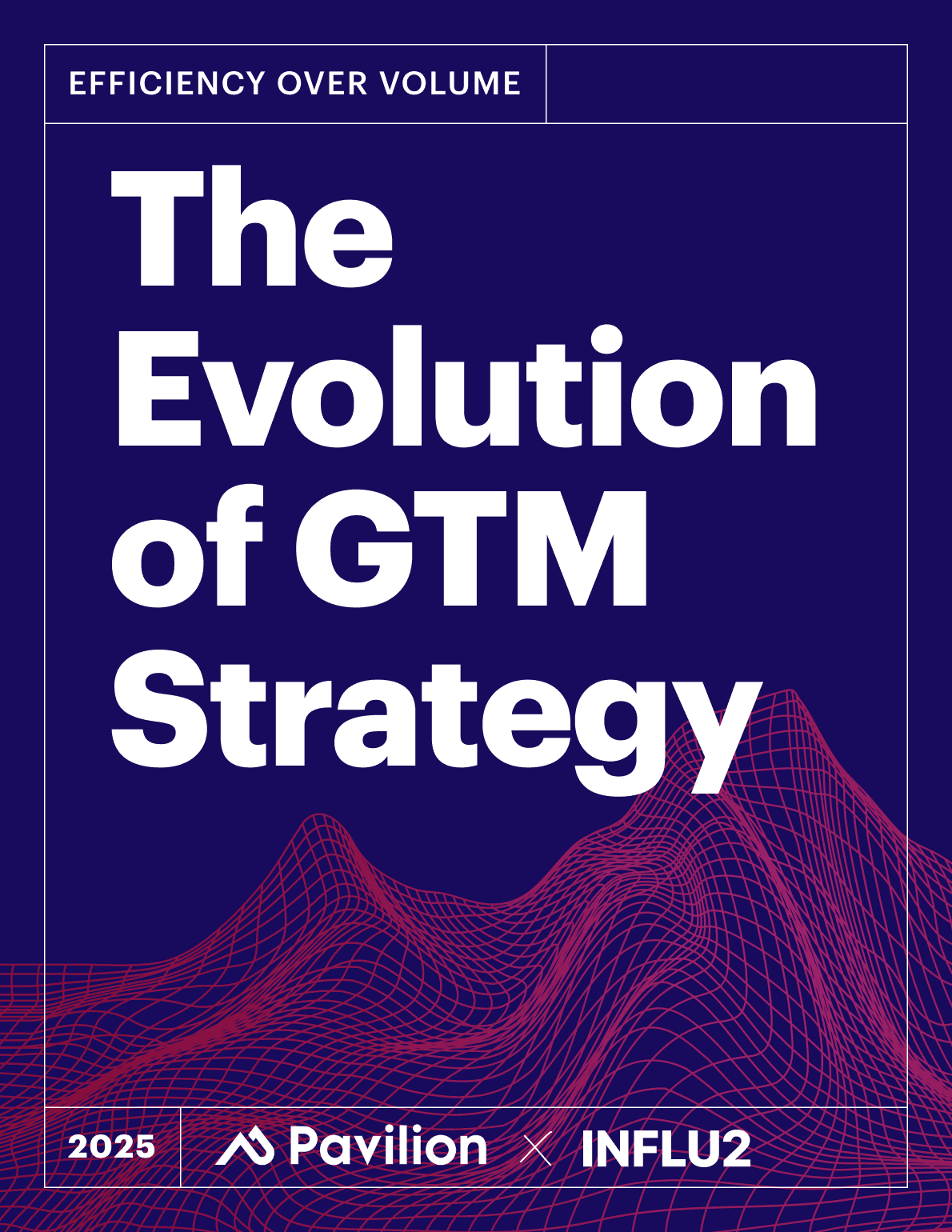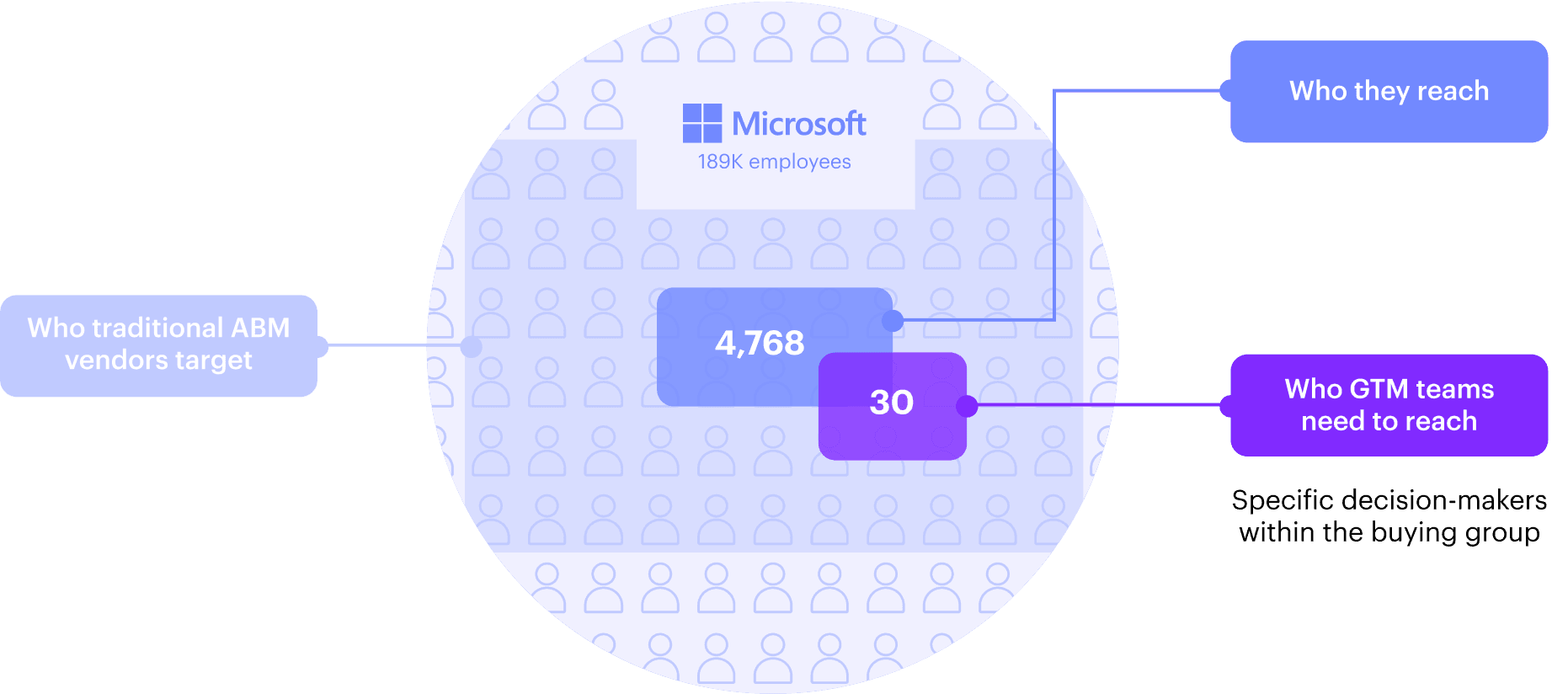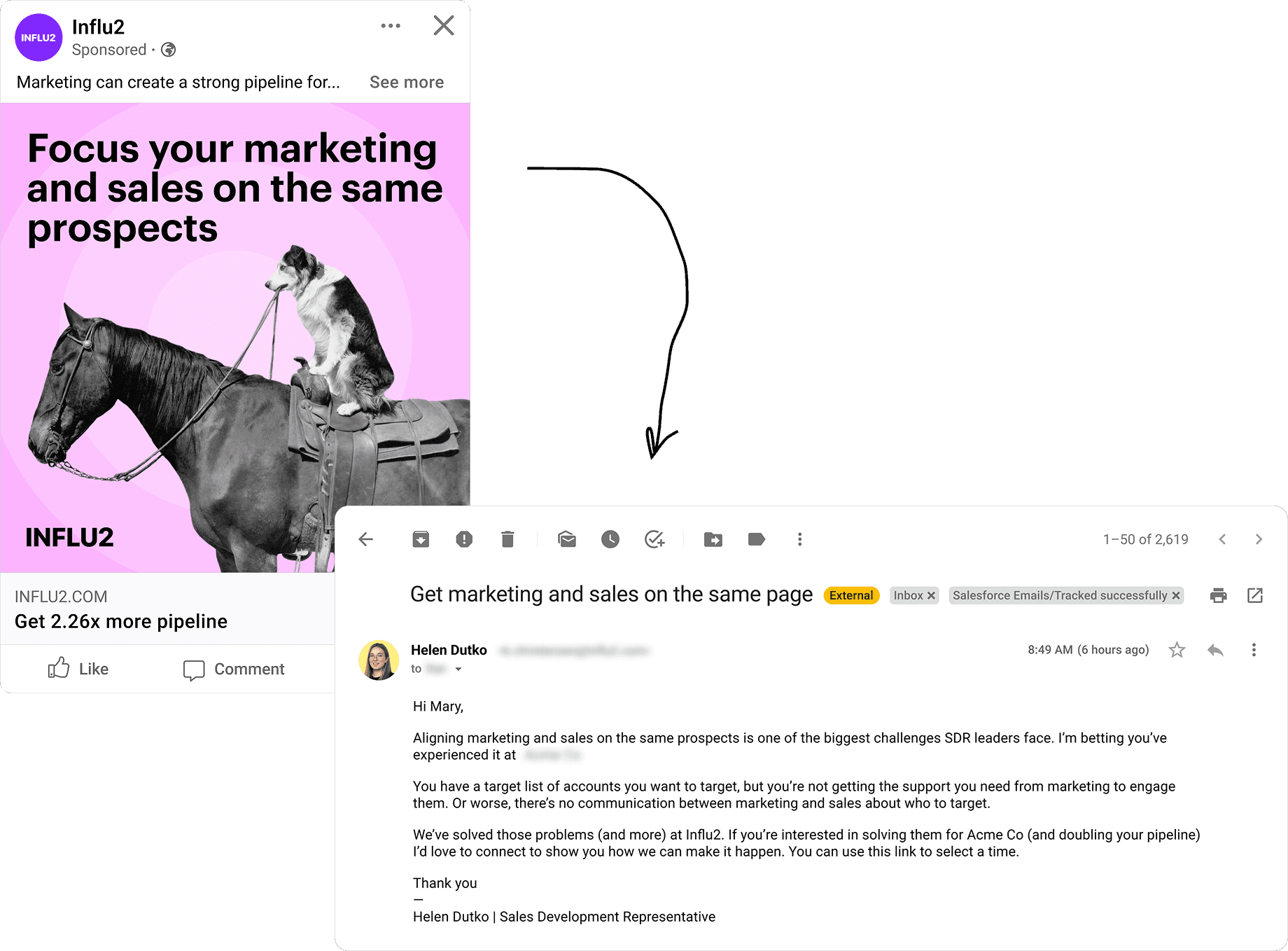Pavilion x Influ2: The Evolution of GTM Strategy

What's inside






Growing revenue goals continue to pile pressure on GTM teams. Unfortunately, that pressure has led teams to brute-force their way to pipeline: more cold calls, more emails, more content, more leads. But it’s not moving the needle. Cold call success rates have halved, and 54% of buyers report feeling overwhelmed by the sheer amount of content they encounter during the decision-making process.
The problem? Volume-based GTM sacrifices precision for scale. It sends Marketing and Sales in different directions, floods Sales with low-quality leads, and wastes time on people who were never going to buy in the first place. The fix isn’t more effort, it’s more focus.
High-performing GTM teams are flipping the script. They’re aligning around tightly defined ICPs, targeting specific buyers (not just accounts and lookalike audiences), and using data to guide their decisions. We spoke with five GTM leaders to learn the key inefficiencies that hinder success and how they’re building more focused, aligned, and effective programs. From these conversations emerged four key opportunities that Sales and Marketing can take advantage of to improve efficiency (and results) across their organization.
One team, one goal
Before any efficiency gains can happen, one foundational shift has to occur: Sales and Marketing must operate as a single revenue team.
Silos are still one of the biggest blockers to GTM performance. As Ali Syed, AVP of International Revenue & Growth at ZoomInfo, puts it: “The number one issue creating inefficiencies is silos across business units.” When Marketing and Sales run separate plays, opportunities get lost, messaging gets muddled, and pipeline suffers.
The best GTM teams don’t see marketing and sales as distinct functions — they see them as a united front. Jennifer Ravalli, CMO at Wedgewood, says she is a “full funnel marketer” because her team stays involved through every stage of the deal. “The minute marketing doesn’t think of themselves as a revenue-generating team is when breakdowns happen,” warns Christina Bottis, CMO at Mural.
Efficiency starts with structural alignment. Everything else — audience targeting, engagement, revenue influence — depends on Marketing and Sales rowing in the same direction. The next four sections break down how high-performing teams are doing exactly that.
The minute marketing doesn’t think of themselves as a revenue-generating team is when breakdowns happen.
Opportunity 1. Actively create audience alignment between Sales and Marketing
The problem
Silos between Marketing and Sales lead to these teams targeting different audiences, resulting in disjointed efforts, wasted budget, and missed revenue opportunities.
The solution
Audience misalignment is a telltale sign of an inefficient GTM strategy.
When Marketing and Sales aren’t aligned around the same target audience, the result is a leaky sales pipeline, missed intent signals, and wasted budget. Syed gives just one example of waste due to audience misalignment: “An MQA will go down to the sales team, but when the sales team speaks to the buying committee, they aren’t interested or aren’t in the market.” Sales will waste time chasing bad-fit leads, and Marketing will over-invest in content that doesn’t land.
This misalignment often stems from Marketing owning top-of-funnel and Sales handling everything after. This division leads to a disconnect on which audience matters to each team. “One flaw in how Marketing thinks is that their job stops once there’s an open opportunity. It shouldn’t,” says Allyson Havener, CMO at TrustRadius.
Volume-based incentives are a leading reason for this funnel division and audience misalignment. If Marketing is incentivized to generate a high volume of leads without aligning with Sales on specific engagement or buying signals, Sales will be left frustrated as they sift through unqualified leads.
Creating audience alignment between GTM teams is much easier said than done. “Our business is 10 years old, and I think we only reached alignment on ICPs and buyer personas maybe 2 or 3 years back,” says Sara Archer, CRO at ChartMogul. The question is, how do you do it?
ICP determination must be an intensely collaborative and data-driven process to ensure audience alignment between Marketing and Sales.
ICP alignment doesn’t happen by accident. Communication and collaboration need to happen from the beginning. “You have to make goals together, with constant communication between teams,” says Bottis. “As soon as you’re making calls alone, there will be disconnects down the funnel.”
The right ICP helps teams align around prospects that are most likely to find success with your product. Uncovering this profile comes from examining your most satisfied customers, and it’s impossible to do so without the right data. “Alignment happened at ChartMogul because we looked at historical retention data,” says Archer. She and her team used retention data to quantify which customers get the most value from the ChartMogul product, allowing them to match key attributes of those customers with prospects in the market. The result is an increased ability to find leads with a higher chance of conversion and retention, as well as a reduction in time spent on unqualified prospects.
There’s nothing like it when you get super strategic and clear and go after the most impactful accounts you can find.
Opportunity 2. Use contact-level targeting to connect with key decision makers within an ICP
The problem
Account-level targeting means teams don’t know if their ads are actually reaching their intended buyers.
The solution
Account and persona-level targeting forces GTM teams to cast a wide net, hoping to reach relevant buyers. But the reality is that most of the people you reach have no influence over purchasing decisions.
The consensus among the GTM leaders we interviewed was that a contact-level approach leads to higher conversion rates, but it’s difficult to scale without the right tools and systems in place. Syed indicates that his team at ZoomInfo uses a combo approach of engaging specific contacts with broad account-based targeting: “If we see potential for a high-spending customer, we will deploy a higher touch personalized approach to that contact.”
This was a common theme that arose in our conversations: Volume and efficiency, scale and precision, are again at odds.
Creating efficiency:
Use contact-level advertising to focus on the buyers you want to reach in a scalable way.

A growing number of teams are successfully scaling this approach: using contact-level ads to target named buyers with persona-level messaging that’s relevant to where each buyer is in their journey.
Rather than aiming broadly at an account or department, this strategy focuses on reaching the exact buyers the sales team is actively pursuing. It helps deliver highly relevant ads at scale and provides visibility into when and how each buyer engages with those ads.
When Marketing targets at the contact level, they waste fewer resources because they are reaching the specific buyers Sales wants to engage.
When Sales aligns around these same contacts, their outreach is more successful. Sales will know exactly which content has reached which people, meaning they aren’t going in cold.
If we see potential for a high-spending customer, we will deploy a higher touch personalized approach to that contact.
Opportunity 3. Operationalize data to reveal intent signals, allowing for effective outreach prioritization
The problem
Without knowing who intent signals came from, salespeople can’t effectively prioritize outreach. This results in lower win rates despite high activity levels because they lack guidance on whom to reach out to and when.
The solution
Account-level intent data indicates to salespeople that someone at the target account is interested, but who is it? SDRs and AEs will need to spend additional time researching who they think the intent signal came from, or send mass emails to entire departments, hoping to reach the right person. In either instance, it’s inefficient and tanks conversion rates.
Creating efficiency:
Use contact-level engagement data to help salespeople prioritize people (not just accounts) showing real buying intent, instead of wasting time on cold outreach.
Almost all of the GTM leaders we interviewed reported using engagement and intent data to prioritize outreach. Bottis says that her team considers firmographic data and seasonal trends in buyer behavior, but “the real beauty is the behavioral triggers. What are the triggers that drive people to take action?” The “beauty” of intent data is that it allows sales teams to spend time with prospects demonstrating interest, and it reveals how they should approach these prospects to establish their business’s value. “I always want to tell Sales something about their buyers that they don’t know,” concludes Bottis.
In addition to telling teams the specific buyer showing intent, contact-level intent data also helps uncover the buyer’s particular problems and pressure points. For example, knowing which ad a specific person clicked helps Sales know what to say when they reach out.

Opportunity 4. Measure Marketing’s impact on revenue to analyze and refine what’s working
The problem
Most marketing teams don’t have concrete ways to see how, or if, they’re influencing revenue. They can track clicks, leads, and last-touch attribution, but those don’t tell the whole story of the impact that marketing content can have on the sales cycle. Syed is actively looking to “move away from last click attribution” at ZoomInfo. “It’s just not true anymore,” he adds.
The solution
Sales starts to wonder how Marketing is actually contributing to increasing the efficiency of sales cycles. What are they doing to help create pipeline and close deals? “Marketing is a key contributor to growth and excitement within the business. How can we get to looking at as many data points as possible to show this?” says Ravalli.
When Marketing can’t show impact, Sales loses confidence, budgets get cut, and campaigns lose momentum. The integration of Sales and Marketing, which is key to an efficient GTM approach, is halted because Marketing’s impact isn’t clearly quantified and understood. There is also no chance for Marketing to use data to fine-tune its program.
Creating efficiency:
Measure Marketing’s influence on pipeline and revenue, not just how many leads they generate.
- Modern marketing tools are creating ways to quantify ‘marketing-influenced’ revenue that goes beyond typical attribution models.
- Marketing-influence models capture the lost credit that attribution models miss.
The GTM leaders we interviewed are all looking for ways to quantify how Marketing influences revenue and pipeline. At Wedgewood, Ravalli does a form of A/B testing to help quantify Marketing’s impact. Her team compares the size and speed of sales cycles where prospects engaged with Marketing to those where prospects didn’t engage. At Mural, Bottis quantifies Marketing’s revenue influence by examining how her team helps cross-sell and upsell their existing customer base.
But these strategies are not all-encompassing. What if a customer sees marketing content, doesn’t interact with it, but then thinks about it a few days later before engaging? And as Archer notes, there are other ways that Marketing influences the buyer journey, including creating “positive feelings” and “trust” around the brand.
How can the impact of this influence be measured? Modern marketing tools are creating ways to quantify ‘marketing-influenced’ revenue that goes beyond typical attribution models. Marketing-influence models capture the lost credit that attribution models miss.
For example, with contact-level advertising, teams can quantify how ads influence the actions of individual members of the buying group. When ad engagement is captured at a contact level, marketing teams know who saw and clicked each ad, even if that viewer doesn’t fill out a lead gen form. It’s a unique ability that gives marketing teams the opportunity to demonstrate their impact in the event that Sales converts a buyer who saw or clicked your ads but never filled out a form. Traditional attribution models would not capture this influence.
With this data, it’s now clear to Sales that Marketing is helping influence the efficiency of their sales cycle, which enhances the cohesiveness of the GTM operation.
Conclusion
The go-to-market motion is shifting. Growth no longer comes from flooding the funnel — it comes from aligning tightly around the right buyers, engaging them with precision, and proving impact at every stage of the journey.
Volume alone won’t drive results. It leads to wasted spend, siloed teams, and bloated pipelines full of unqualified leads. The teams seeing real gains are doing things differently: breaking down internal silos, aligning early on ICPs, engaging at the contact level, and using data to guide every decision.
Efficiency isn’t just about doing more with less — it’s about doing the right things, together. When Sales and Marketing operate as one team, with shared data, shared targets, and shared accountability, the entire GTM engine becomes faster, smarter, and more effective.







